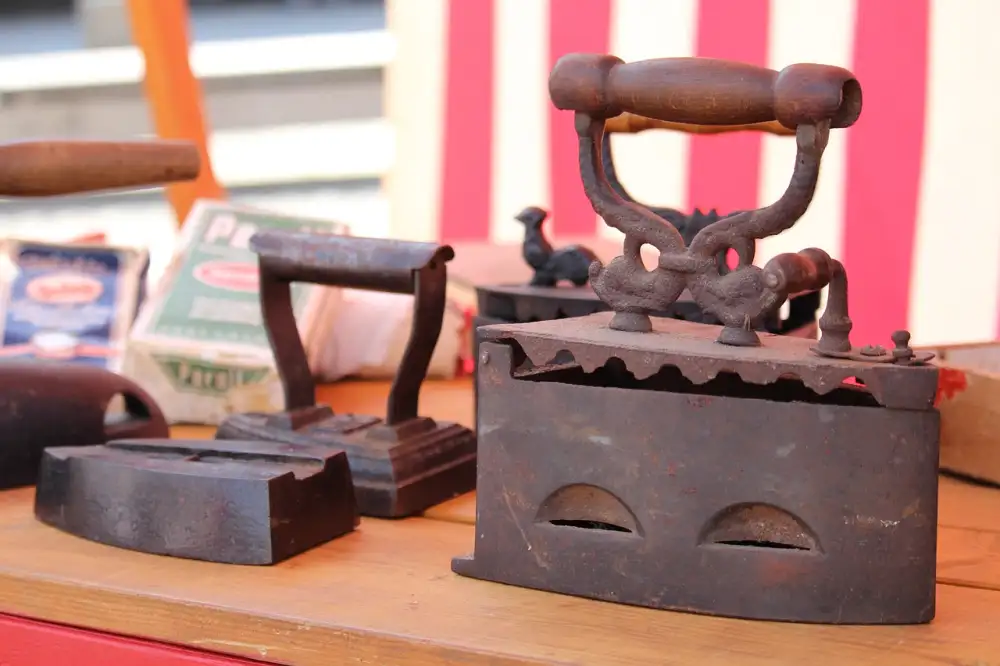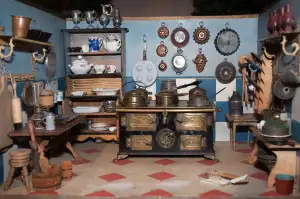The Ultimate Guide: How to Wash a Cast Iron Skillet Like a Pro

- Why cleaning a cast iron skillet is important
- Preparing the skillet for cleaning
- Cleaning the skillet
- Using hot water and a brush
- Avoiding soap and harsh detergents
- Removing stubborn food particles
- Drying the skillet
- Towel drying
- Air drying
- Seasoning the skillet
- Applying a thin layer of oil
- Heating the skillet
- Cooling and storing the skillet
A cast iron skillet is a beloved kitchen tool that has been passed down through generations. Its ability to retain heat and create a perfect sear makes it a favorite among chefs and home cooks alike. However, to ensure its longevity and optimal performance, proper cleaning and maintenance are essential. In this ultimate guide, we will take you through the step-by-step process of washing a cast iron skillet like a pro. From preparing the skillet for cleaning to seasoning it for future use, we've got you covered. So let's dive in and discover the secrets to keeping your cast iron skillet in top shape!
Why cleaning a cast iron skillet is important
Cleaning a cast iron skillet is crucial for maintaining its longevity and ensuring the best cooking experience. Here's why it's important:
1. Prevents rust: Cast iron is prone to rusting when exposed to moisture. Regular cleaning removes any moisture and prevents the formation of rust, which can ruin the skillet.
2. Removes food residue: Cleaning eliminates leftover food particles that can become rancid over time, affecting the taste of future dishes. It also prevents the buildup of bacteria and other harmful microorganisms.
3. Enhances flavor: A clean skillet allows you to fully enjoy the natural flavors of your ingredients without any unwanted tastes from previous meals.
4. Improves non-stick properties: Proper cleaning helps maintain the seasoning on the skillet, creating a natural non-stick surface. This makes cooking easier and reduces the need for excessive oil or butter.
By understanding why cleaning a cast iron skillet is important, you can ensure its longevity and continue to create delicious meals for years to come.
Preparing the skillet for cleaning
Preparing the skillet for cleaning is an essential step to ensure effective and safe cleaning. Start by allowing the skillet to cool down completely after use. This will prevent any potential burns or injuries during the cleaning process. Once cooled, gently scrape off any excess food particles using a wooden spatula or scraper. Be careful not to scratch the surface of the skillet. Next, rinse the skillet with warm water to remove any loose debris. Avoid using cold water as it can cause thermal shock and damage the skillet. With these simple steps, you are now ready to proceed with cleaning your cast iron skillet like a pro.
Cleaning the skillet
Cleaning the skillet is an essential step to maintain its quality and prolong its lifespan. To clean a cast iron skillet, start by using hot water and a brush. Gently scrub away any food residue or grease. Avoid using soap or harsh detergents, as they can strip away the skillet's seasoning.
For stubborn food particles, create a paste of coarse salt and water. Apply it to the affected areas and scrub gently with a brush. The abrasive nature of salt helps to remove stuck-on food without damaging the skillet's surface.
Rinse the skillet thoroughly with hot water to ensure all the salt and food particles are removed. Pat dry with a towel to prevent any moisture from causing rust.
Remember, air drying is not recommended for cast iron skillets as it can lead to rust formation. Instead, place the skillet on low heat on your stovetop until it is completely dry.
Once dry, it's time to season the skillet. Apply a thin layer of oil all over the surface, including the handle. Use a paper towel to spread the oil evenly. Heating the oiled skillet on low heat helps in polymerizing the oil, creating a non-stick layer.
Allow the skillet to cool before storing it in a dry place. Stacking other cookware on top of it may cause damage, so store it separately if possible.
By following these cleaning steps regularly, you can maintain your cast iron skillet's integrity and enjoy cooking with it for years to come.
Using hot water and a brush
Using hot water and a brush is an effective method for cleaning a cast iron skillet. Start by rinsing the skillet under hot running water to remove any loose food particles. Then, use a stiff-bristled brush or sponge to scrub the surface of the skillet. The hot water helps to loosen any stuck-on food, making it easier to remove. Be sure to scrub all areas of the skillet, including the sides and bottom. This method helps to maintain the seasoning on the skillet while still ensuring it is clean and ready for future use.
Avoiding soap and harsh detergents
When it comes to cleaning a cast iron skillet, one important rule to remember is to avoid using soap and harsh detergents. This is because these substances can strip away the seasoning that gives the skillet its non-stick properties and enhances its flavor. Soap can also leave behind a residue that affects the taste of future dishes cooked in the skillet.
Instead, opt for using hot water and a brush to clean your cast iron skillet. The heat helps to break down any food particles stuck on the surface, making them easier to remove. Gently scrub the skillet with a brush or sponge, ensuring you reach all corners and crevices.
By avoiding soap and harsh detergents, you preserve the natural oils and seasoning of the skillet, maintaining its non-stick surface. This not only ensures better cooking performance but also prolongs the lifespan of your cast iron cookware.
Remember, if there are stubborn food particles that won't come off with just hot water and brushing, you can use a gentle scraper or salt to help loosen them without damaging the skillet's surface. Just be sure to rinse thoroughly afterward to remove any remaining salt.
Taking these precautions will help you maintain your cast iron skillet in optimal condition for years of delicious cooking experiences.
Removing stubborn food particles
Removing stubborn food particles from a cast iron skillet can be a bit challenging, but with the right techniques, it can be done effectively. One method is to fill the skillet with water and bring it to a boil. This will help loosen any stuck-on food. Then, using a wooden or silicone spatula, gently scrape off the residue. Be careful not to use metal utensils as they can damage the seasoning of the skillet. For tougher stains, sprinkle some coarse salt onto the surface and scrub it with a damp cloth or sponge. The abrasive nature of salt helps in breaking down stubborn food particles without causing any harm to the skillet's surface. Once all the residue is removed, rinse the skillet thoroughly with hot water and proceed with drying and seasoning as mentioned earlier. Remember, patience and gentle cleaning techniques are key to maintaining your cast iron skillet in top condition for years to come.
Drying the skillet
Drying the skillet is an important step to prevent rusting and maintain its longevity. There are two methods you can use: towel drying and air drying.
After rinsing off any remaining food particles, gently dry the skillet with a clean towel. Make sure to remove all moisture from the surface, including the handle and edges. This will help prevent any water spots or potential rust formation.
Alternatively, you can opt for air drying. Simply place the skillet in a well-ventilated area and allow it to naturally dry. This method is particularly useful if you're concerned about lint or fibers sticking to the skillet during towel drying.
Regardless of which method you choose, ensure that the skillet is completely dry before proceeding to the next step. Moisture left on the surface can lead to rusting, which can ruin your beloved cast iron skillet.
By properly drying your cast iron skillet after cleaning, you are taking an essential step in maintaining its quality and ensuring it lasts for years to come.
Towel drying
Towel drying is an essential step in properly cleaning a cast iron skillet. After rinsing the skillet with hot water and scrubbing away any food particles, gently pat it dry with a clean towel. This helps to remove excess moisture and prevent any potential rusting. It's important to ensure that the skillet is completely dry before moving on to the next step of seasoning. Remember, moisture can cause the skillet to rust, so take your time and make sure it's thoroughly dried before proceeding.
Air drying
Air drying is an essential step in properly cleaning a cast iron skillet. After towel drying, it is important to allow the skillet to air dry completely before moving on to the next step. This is because any moisture left on the surface can lead to rusting.
To air dry the skillet, simply place it in a well-ventilated area and let it sit undisturbed for several hours or overnight. It is crucial to ensure that there is no moisture trapped in any crevices or handles of the skillet.
By allowing the skillet to air dry naturally, you are giving it time to evaporate any remaining water and ensuring that it is completely dry before proceeding with seasoning. This will help maintain the integrity of the cast iron and prevent any potential damage.
Remember, never rush the drying process by using heat or placing the skillet in direct sunlight, as this can cause uneven drying and potentially warp or crack the skillet. Patience is key when air drying your cast iron skillet, as it ensures that you are taking proper care of this beloved kitchen tool.
Seasoning the skillet
Seasoning the skillet is a crucial step in maintaining its non-stick surface and preventing rust. To season the skillet, start by applying a thin layer of oil to the entire surface, including the handle. Use a paper towel or cloth to evenly distribute the oil. Next, heat the skillet over medium-high heat for about 10 minutes. This helps the oil penetrate and bond with the iron, creating a protective layer. Allow the skillet to cool completely before storing it. Avoid using too much oil as it can become sticky and affect the seasoning process. Regularly seasoning your cast iron skillet will enhance its performance and prolong its lifespan.
Applying a thin layer of oil
Applying a thin layer of oil is an essential step in maintaining the quality and longevity of your cast iron skillet. After cleaning and drying the skillet, it's important to prevent rust by applying a protective layer of oil. Start by choosing a high smoke point oil such as vegetable oil or flaxseed oil. Using a paper towel or cloth, apply a small amount of oil to the entire surface of the skillet, ensuring all areas are covered. Be sure to use just enough oil to create a thin, even coating. Excess oil can lead to sticky residue or a gummy surface. The oil acts as a barrier against moisture and helps maintain the non-stick properties of the skillet. By regularly applying this thin layer of oil after each use, you'll keep your cast iron skillet in prime condition for many delicious meals to come.
Heating the skillet
Heating the skillet is an essential step in the process of seasoning. After applying a thin layer of oil to the skillet, it is important to heat it to a specific temperature. This helps to create a protective layer on the surface of the skillet, preventing rust and enhancing its non-stick properties.
To heat the skillet, place it on a stovetop burner set to medium-high heat. Allow the skillet to heat for about 5-10 minutes or until it starts to smoke slightly. This indicates that the oil has reached its smoke point and is bonding with the iron surface.
During this heating process, make sure to use oven mitts or pot holders as the handle will become extremely hot. It is also recommended to open windows or turn on ventilation as there may be some smoke produced during this step.
Once heated, carefully remove the skillet from the heat source and allow it to cool completely before using or storing. The cooling process allows the oil to solidify and form a protective layer on the skillet's surface.
By following these steps and heating your cast iron skillet properly, you will ensure that it remains in optimal condition for years to come, ready to create delicious meals with exceptional flavor.
Cooling and storing the skillet
Cooling and storing the skillet is the final step in maintaining its longevity and preventing rust. After seasoning, allow the skillet to cool completely before handling. Avoid placing it directly under cold water as sudden temperature changes can cause it to warp. Once cooled, store the skillet in a dry place to prevent moisture buildup. To further protect against rust, place a paper towel or cloth inside the skillet to absorb any excess moisture. With proper cooling and storage, your cast iron skillet will be ready for many more delicious meals to come.
In conclusion, knowing how to properly wash and care for your cast iron skillet is essential in maintaining its longevity and performance. By following the steps outlined in this guide, you can ensure that your skillet remains clean, seasoned, and ready to use for many years to come.
Regularly cleaning your cast iron skillet not only removes any food residue but also helps prevent the buildup of harmful bacteria. Avoid using soap or harsh detergents as they can strip away the skillet's seasoning and affect its non-stick properties.
After cleaning, make sure to thoroughly dry the skillet to prevent rusting. Towel drying is effective, but allowing it to air dry completely is also an option.
To maintain the skillet's seasoning, apply a thin layer of oil after each use. This helps create a protective barrier against moisture and prevents rust formation. Heating the oiled skillet further enhances its seasoning.
Finally, store your cast iron skillet in a cool and dry place. Avoid stacking other cookware on top of it to prevent any damage.
By following these steps, you can enjoy cooking with your cast iron skillet for generations, creating delicious meals that truly reflect your love for food.
Published: 17. 02. 2024
Category: Home



